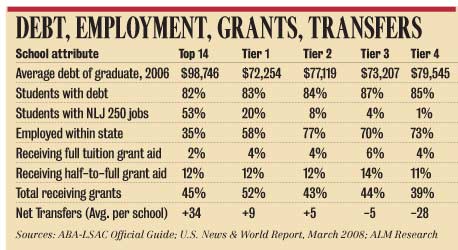
seems to say that t1 is a bad financial decision, at least for nlj250, and still leave most with only around 10 thousand dollars less debt per year. (this may represent an average of a group that has much more and a group that has much less)
On top of that, for Biglaw:
--ImageRemoved--
It seems that even the top schools only are around 50% (even with people choosing other options like clerkship) and that as you go down the list the percentages are not drastically less (not sure if this would continue all the way down to Vandy or wustl of Illinois etc. or not)
check out http://www.law.com/jsp/nlj/PubArticleNL ... hbxlogin=1 for the top 50 (courtesy of ahduth)
Also, here is some clerkship data
1st # -Percent employed in all judicial clerkships
2nd # - Percent employed in a judicial clerkship by an Article III federal judge
1 Yale University
New Haven, CT
35.1% 31.4%
2 Stanford University
Stanford, CA
23.0% 22.0%
3 Harvard University
Cambridge, MA
19.0% 15.5%
4 Duke University
Durham, NC
16.0% 13.0%
5 University of Chicago
Chicago, IL
13.0% 13.0%
6 University of Pennsylvania
Philadelphia, PA
16.5% 12.8%
7 University of Virginia
Charlottesville, VA
13.6% 11.8%
8 Columbia University
New York, NY
11.0% 11.0%
9 Vanderbilt University
Nashville, TN
15.0% 10.6%
10 University of Georgia
Athens, GA
17.0% 10.4%
11 Northwestern University
Chicago, IL
12.0% 9.4%
12 Washington and Lee University
Lexington, VA
20.0% 9.0%
13 University of Texas--Austin
Austin, TX
13.0% 9.0%
14 University of Michigan--Ann Arbor
Ann Arbor, MI
13.6% 9.0%
15 Emory University
Atlanta, GA
9.1% 9.0%
16 New York University
New York, NY
10.5% 8.5%
17 Washington University in St. Louis
St. Louis, MO
10.5% 8.2%
the whole list is at http://grad-schools.usnews.rankingsandr ... iii_clerks
This time there is a bigger difference between t14s especially (YHS) and also a lot of variance between schools of all ranks. It seems this statistic need a lot of interpretation.